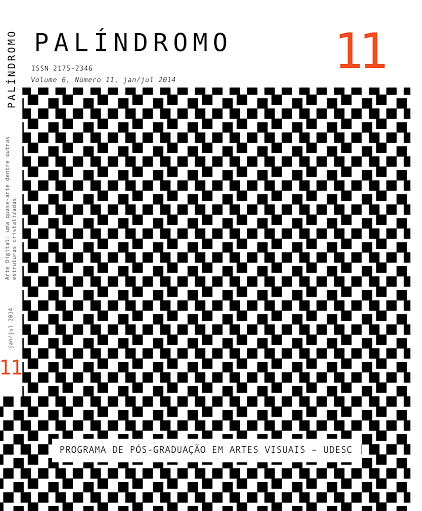Tecnofobia: mudanças tecnológicas e transformações na percepção humana
DOI:
https://doi.org/10.5965/2175234606112014098Palabras clave:
Novas tecnologias , corpo e máquina , medo de tecnologia , arte e tecnologiaResumen
Hannah Arendt classifica o fazer humano em três diferentes categorias: trabalho, obra e ação. Este artigo pretende relacionar estas categorizações com o conceito de tecnologia de diversos autores, tais como Cupani, Dias e Epstein, que indicam que o objeto tecnológico é mais abrangente do que aponta o senso comum. Sendo o objeto tecnológico intimamente relacionado aos conceitos de produção de Arendt, evidenciou-se a importância das tecnologias na condição humana, que, segundo a autora, depende principalmente da capacidade de o homem produzir. Conforme este contexto, o texto apresenta uma relação entre homem e máquina, e as relações subjetivas propostas pelo objeto artístico da arte tecnologia, analisando, assim, o quadro em que o homem se relaciona com a máquina em seu ambiente, construindo relações e influências que permeiam toda a cultura.
Descargas
Citas
ARENDT, Hannah. A condição humana. 11. ed. Rio de Janeiro: Forense Universitária, 2011.
BRET, Michel. Apprendre et créer par l’expérimentation interactive. Disponível em: <http://www-inrev.univ-paris8.fr/extras/Michel-Bret/cours/bret/art/2005/appren- dre_et_creer/apprendre_et_creer.htm>. 2005.
CUPANI, Alberto. Filosofia da Tecnologia: Um convite. Florianópolis: Editora da UfSC, 2011.
DIAS, Cristiane. A escrita como tecnologia da linguagem. Coleção Hipers@beres – Livro Digital: Tecnologias de linguagem e produção do conhecimento, Santa Maria, 2009.
EPSTEIN, Isaac. Cibernetica. São Paulo: Ática, 1986. 88p. (Serie Principios ; v.62).
LAFUNAMBULE Virtuelle. São Paulo: Emoção Art.ficial, 2000. Vídeo de internet, P&B. Disponível em: <http://www.emocaoartficial.org.br/en/artistas-e-obras/emocao-3-0/>. Acesso em: 5 abr. 2014.
LEVY, Pierre. O que é o virtual? São Paulo: Editora 34, 1996.
MIKKELSON, David P. (Org.). Ban dihydrogen monoxide! Collected via e-mail, 1997. Disponível em: <http://www.snopes.com/science/dhmo.asp>. Acesso em: 3 abr. 2013.
NARDIN, H. O. Objeto e Instalação - Processos de criação e apreciação em artes plás- ticas. In: ENCONTRO CENTRO-OESTE ANPAP, 1., 2000, Goiânia, GO; Anais… Goiânia, GO: ANPAP, 2000.
PLAZA, Julio. ARTE E INTERATIVIDADE: AUTOR-OBRA-RECEPÇÃO, 2000. Disponível em: <http://www.ehu.es/netart/alum0506/Ines_Albuquerque/ARTE E INTERATIVI- DADE.htm>. Acesso em: 25 out. 2013.
POLD, Søren Bro. “Interface Perception: The Cybernetic Mentality and It´s Critics: Übermorgen.com”. In: ANDERSEN, Christian Ulrik; POLD, Søren Bro. Interface Criti- cism. Aesthetics Beyond Buttons. Aarhus University Press, 2011, pp. 91- 113.
SANTAELLA, Lúcia. Por que as comunicações e as artes estão convergindo. São Pau- lo: Paulus, 2005.
SOGABE, Milton. Arte e tecnologia. In: LEÃO, Lúcia. DERIVAS: Cartografias do cibe- respaço. São Paulo: Anna Blume; Senac, 2004. pp. 127-135.
______. Falsa Interface como recurso poético na obra interativa. In: ENCONTRO NACIONAL ANPAP, 2013, Belém. Anais... Belém: ANPAP, 2013. pp. 2276-2282.
VASCONCELLOS, Maria José Esteves de. Pensamento Sistêmico: O novo paradigma da ciência. 7a edição Campinas, SP: Papirus, 2002.
Descargas
Publicado
Cómo citar
Número
Sección
Licencia
Derechos de autor 2014 Rodrigo Born

Esta obra está bajo una licencia internacional Creative Commons Atribución 4.0.
DECLARAÇÃO DE DIREITOS AUTORAIS
a. Os artigos publicados pela revista são de uso gratuito, destinados a aplicações acadêmicas e não comerciais. Todos os direitos autorais são atribuídos à revista. Os artigos cujos autores são identificados representam a expressão do ponto de vista de seus autores e não a posição oficial da Revista Palíndromo. O (s) autor (es) compromete-se sempre que publicar material referente ao artigo publicado no Palíndromo mencionar esta publicação da seguinte forma:
Este artigo foi publicado originalmente pela revista Palíndromo em seu volume (coloque o volume), número (coloque o número) no ano de (coloque o ano) e pode ser acessado em: http://www.revistas.udesc.br/index.php/palindromo
b. Plágio, em todas as suas formas, constitui um comportamento antiético de publicação e é inaceitável. A revista Palíndromo utiliza o software iThenticate de controle de similaridade


